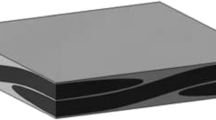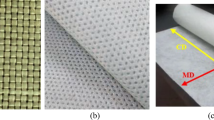An analytical method for designing layered high-modulus and high-strength fibrous hybrid composite materials with a highly nonlinear mechanical behavior is put forward. The elastic and strength characteristics of unidirectional layers of the composites were determined experimentally. Then, the parameters of Weibull distribution of the strength of carbon and glass fibers were estimated using test results for specimens of hybrid structure with a preliminary calculated number of carbon plastic layers in the composite. Using the criterion of maximum structural strength with a restricted elastic modulus and proportionality limit, the structure of a hybrid composite with thin CFRP and GFRP layers is optimized. A kinematic loading of a hybrid composite in which all layers deform together without stratification is considered. The Daniels model of dry bundle, with account of Weibull distribution of fiber strength, is employed to consider the decrease in the stiffness of composite layers and of the composite as a whole caused by microdefects. The approach offered was used in the design of a \( \left[{0}_m^{\mathrm{c}}/{0}_{1-m}^{\mathrm{g}}\right] \) pseudoductile hybrid carbon/glass plastic with the highest structural strength. It was found that m ≈ 0.30, which agreed with experimental data.











Similar content being viewed by others
References
I. M. Daniel and O. Ishai, Engineering Mechanics of Composite Materials, 2nd ed., Univ. Press, Oxford (2006).
R. F. Gibson, Principles of composite materials mechanics, 2nd ed., CRC Press, (2007).
M. Montemurro, A. Pagani, G. A.Fiordilino, J. Pailhès, and E. Carrera, “General multi-scale two-level optimisation strategy for designing composite stiffened panels,” Compos. Struct., 201, 968-979 (2018).
A. Sohouli, M. Yildiz, and A. Suleman, “Cost analysis of variable stiffness composite structures with application to a wind turbine blade,” Compos. Struct., 203, 681-695 (2018).
H. Völkl, D. Klein, M. Franz, and S. Wartzack, “An efficient bionic topology optimization method for transversely isotropic materials,” Compos. Struct., 204, 359-367 (2018).
S. Kim, H. Cho, H. Joo, S. Shin, and J. Kwak, “Equivalent structural modeling using laminated composite shell analysis for the nozzle component of a launch vehicle engine,” J. Aerospace Eng., 31, No. 6, paper No. 04018078 (2018).
S. Yan, X. Zeng, and A. Long, “Experimental assessment of the mechanical behaviour of 3D woven composite T-joints,” Composites: Pt. B, 154, 108-113 (2018).
M. D. Banea, M. Rosioara, R. J .C. Carbas, and L. F. M. da Silva, “Multi-material adhesive joints for automotive industry,” Composites: Pt. B, 151, 71-77 (2018).
A. R. Bunsell and A. Thionnet, “Failure processes governing long term reliability of carbon fibre composite structures,” J. Compos. and Nanomaterials, 7, No. 4, 216-224 (2016).
B. Dang, X. Zhang, Y. Z. Chen, C. X. Chen, H. T. Wang, and F. Liu, “Breaking through the strength-ductility trade-off dilemma in an Al-Si-based casting alloy,” Nat. Sci. Rep., 30874 (2016).
P. H. Petit and M. E. Waddoups, “A method of predicting the nonlinear behavior of laminated composites,” J. Compos. Mater., 3, 2-19 (1969).
H. T. Hahn and S. W. Tsai, “On the behavior of composite laminates after initial failures,” J. Compos. Mater., 8, 288-305 (1974).
R. S. Sandhu, “Nonlinear response of unidirectional and angle-ply laminates,” AIAA, paper 74-380, 20-31 (1974).
S. C. Chou, O. Orringer, and L. H. Rainey, “Post-failure behavior of laminates. Part I. No stress concentrations,” J. Compos. Mater., 10, 371-381 (1976).
S. B. Sapozhnikov, Defects and Strength of the Reinforced Plastics [in Russian], Chelyabinsk (1994).
S. B. Sapozhnikov, S. I. Cheremnykh, and A. G. Maslakova, “Prediction of deformation and biaxial strength of fiber reinforced laminates for WWFE by using microdamage mechanics,” Proc. ECCM13, Stockholm, 2-5 June (2008).
S. B. Sapozhnikov and O. S. Buslaeva, “A prediction of fracture load of fibre reinforced plastic with arbitrary concentrator under tension,” Proc. IV Int. Conf. on Computational Plasticity, COMPLAS IV, Barcelona, 1127-1235 (1995).
A. S. Kaddour, M. J. Hinton, S. Li, and P. A. Smith, “Damage prediction in polymeric composites: Up-date of part (A) of the 3rd World-Wide Failure Exercise (WWFE-III),” ICCM Int. Conf. on Composite Materials (2011).
T. Hayashi, “On the improvement of mechanical properties of composites by hybrid composition,” Proc. 8th Int. Reinforced Plastics Conf., 149-152 (1972).
Manders P. W. and Bader M. G. “The strength of hybrid glass/carbon fibre composites. Part 1. Failure strain enhancement and failure mode,” J. Mater. Sci., 16, No. 8, 22, 33-45 (1981).
G. Kretsis, “A review of the tensile, compressive, flexural and shear properties of hybrid fibre reinforced plastics,” Composites:, 18, No. 1, 13-23 (1987).
G. Czel and M. R. Wisnom, “Demonstration of pseudo-ductility in high performance glass/epoxy composites by hybridisation with thin-ply carbon prepreg,” Composites: Pt. A, 52, 23-30 (2013).
Y. Swolfs, L. Gorbatikh, and I. Verpoest, “Fibre hybridisation in polymer composites: a review,” Composites: Pt. A, 67, 181-200 (2014).
S. B. Sapozhnikov and S. I. Cheremnykh, “The strength of fibre reinforced polymer under a complex loading,” J. Compos. Mater., 47, Nos. 20 and 21, 2525−2552 (2013).
H. E. Daniels, “The statistical theory of the strength of bundles of threads,” Proc. of Roy. Soc. Math. Phys. Eng. Sci., 183, 405-435 (1945).
S. B. Sapozhnikov and A. A. Shabley, “Numerical evaluation of the microdamage kinetics of cross-ply GFRPs based on stochastic micro-meso modeling,” Proc. ECCM18 Europ. Conf. on Composite Materials, Athens, 24-28th June (2018).
H. Neuber, “Theory of stress concentration for shear strained prismatic bodies with nonlinear stress-strain law,” J. Appl. Mech. Ser. E., 28, No. 4, 544-550 (1961).
URL: https: // plastinfo.ru/content/file/gosts/994505825d35.pdf (date of request: 28.08.2018).
URL: http://www.npo-stekloplastic.ru/production/fiber-materials/hm-hs-fiber-materials/vmp-fabrics/t-60-2vmp/ (date of request: 28.08.2018)
URL: www.epital.ru/compounds/etal370.html (date of request: 28.08.2018)
Acknowledgements
This work was carried out at financial support of the Russian Science Foundation (project 18-19-00377). The test specimens were fabricated at the laboratory of composite materials of the Research Institute of Experimental Mechanical Engineering (Director R. A. Zakirov) of the South Ural State University.
Author information
Authors and Affiliations
Corresponding author
Additional information
Translated from Mekhanika Kompozitnykh Materialov, Vol. 55, No. 2, pp. 331-344, March-April, 2019.
Rights and permissions
About this article
Cite this article
Sapozhnikov, S.B., Kheruvimov, A.V. & Bezmel’nitsyn, A.V. Design of Pseudoductile Unidirectional Hybrid Composites Based on the Model of a Dry Bundle. Mech Compos Mater 55, 231–240 (2019). https://doi.org/10.1007/s11029-019-09806-z
Received:
Revised:
Published:
Issue Date:
DOI: https://doi.org/10.1007/s11029-019-09806-z




